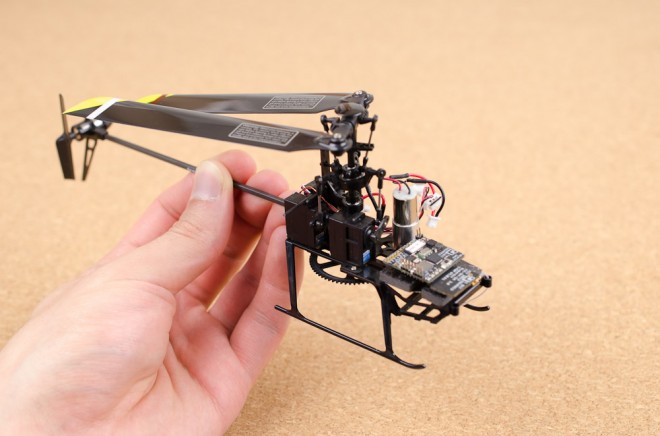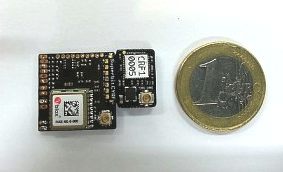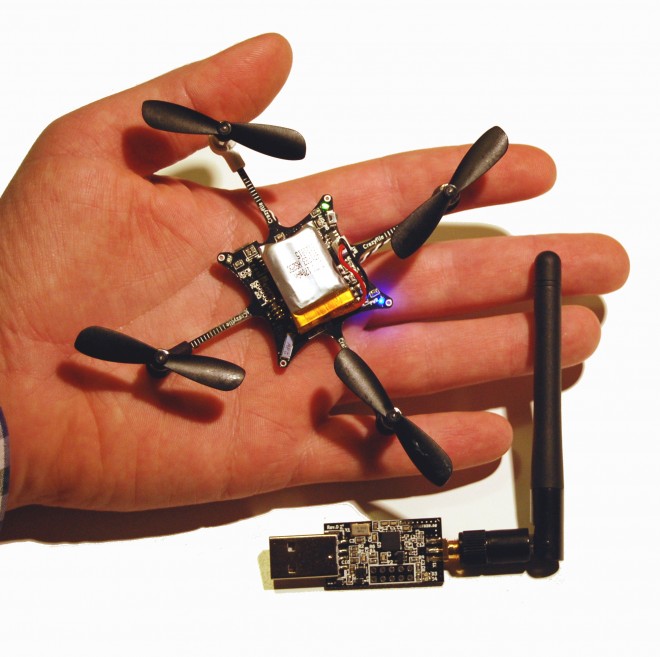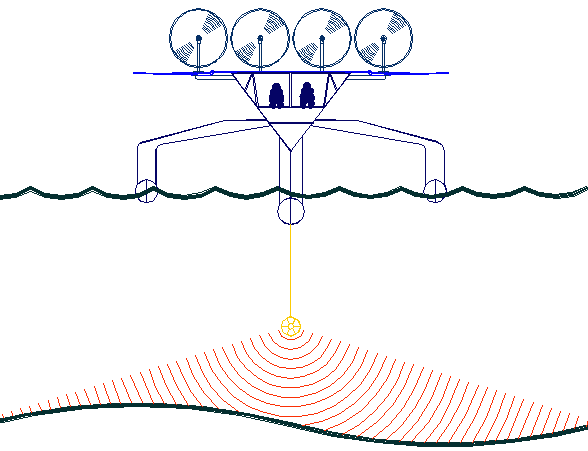|

WORLD'S
SMALLEST DRONE AUTOPILOT
The Lisa/S chip is 4 square-centimeters — about the same size as a Euro coin. But this 1.9-gram sliver of silicon includes everything you need to autopilot an aerial drone.
It’s the world’s smallest drone autopilot system — over 30 grams lighter than its predecessor — according to the chip’s designers at the Delft University of Technology in the Netherlands. And best of all, both the hardware and the software is open source, meaning anyone can copy and use it — for free.
“The main reason we chose open source is that we want to make it available for society,” says the project’s leader, Bart Remes. He envisions open source drone technology enabling a wider range of civilian drone applications, from agriculture to search and rescue.
“Before, only the military had access to this type of technology,” he says. “My vision is that within a few years, every fireman [will have] a drone in his pocket.”

Remes says he’s been flying remote-controlled aircraft since he was six years old. About 10 years ago, as a student at Delft, he started building his own drones, attracted to the challenges of programming and electronics. It turned out that very small drones — called micro air vehicles, or MAVs — are a great way to teach aerospace engineering because they’re relatively cheap, safe and easy to program.
“At university, a lot of students are working in a compute simulation and never see the real world,” Remes says. “With MAVs, they get to see the real world.” His student work turned into a full-time job as the head of the university’s MAV Laboratory, which is responsible for projects like DelFly, a small wing-flapping drone that resembles a
dragonfly.
The Lisa/S is the MAV Laboratory’s latest project. The chip’s software is based on Paparazzi, an open source drone autopilot system that’s been around since 2003. The real innovation is the hardware. The tiny chip packs in everything you need for an autopilot system, including a gyroscope, accelerometer, altimeter,
GPS, and an ARM processor — the same sort of CPU you might find in your smartphone. The Lisa/S can be used with any type of drone, from quadcopters to fixed-wing systems, Remes says.
The one limitation, he says, is that it can’t provide a continuous data link to its operators. “For us, it’s not a limitation, because it’s autonomous,” he says. “But I can understand that some people need constant data connection to the autopilot, so they’d need a slightly larger link.”
The chip was designed with the help of a US
based electronics company called 1Bitsquared, which will sell Lisa/S chips starting in January 2014. But since both the hardware and software is open source, Remes says any company will be able to sell chips based on the technology.

BITCRAZE
QUAD COPTER DRONE
A tiny new open source drone kit made by Bitcraze is buzzing its way to market this spring, targeted at hackers and modders who want to explore droning indoors as well as out.
Marcus Eliasson, Arnaud Taffanel, and Tobias Antonsson are the engineers behind the
Swedish startup now accepting pre-orders for a palm-sized
quadcopter called the Crazyflie Nano. (Not to be confused with the Norwegian-made nano-copter used by British troops in Afghanistan.)
The trio used only open source material for the project, from mechanics to hardware and code. Not only was it a nod to the open source mantra, it saved them a ton of time; all three have day jobs and have spent the last three years working evenings on the Crazyflie Nano.
“We used what is common knowledge from other open source projects, so we kind of used the same building blocks that have been tested by us and by other open source projects,” says Eliasson.
Though it looks like barely more than four propellers, a battery, and a control board, the team packed multiple sensors and an antenna onto the tiny frame, in an effort to give developers and hackers more to play with.
“At least we hope that people will use it for that,” says Antonsson. “It’s extremely fun to play with as well, just fly around. Our hope is that they will develop on it.” They have already gotten suggestions for modifications, and hacked the copter to carry a video camera, LEDs, and even an inductive charger.
The $149 device is controlled by a PC through a 2.4 GHz radio, and an on-board gyroscope and accelerometer keep it steady. (A more advanced, $173 version, with a magnetometer and altimeter will also be available.) The Crazyflie Nano is available on Seeed, an “open hardware facilitator” that also takes pre-orders, somewhat like
Kickstarter but with less publicity and no goals to reach.
In fact, the team considered crowdfunding the Crazyflie. “We wanted to keep it fun,” says Taffanel. “We didn’t want to say that we were forced to deliver something quickly.”
At less than four inches across and 19 grams, the device is small enough to fly under tables and chairs, and through enclosed spaces.
“It won’t kill you if you do something wrong with it,” says Antonsson. “That’s a big benefit if you’ve been playing with the bigger ones. They can be pretty harmful.”
LINKS
http://www.wired.com/wiredenterprise/2013/08/drone-autopilot/?mbid=social11284284
http://www.wired.com/design/2013/02/crazyflie-nano/

The Bluefish SNAV
platform, presently under development, is a robotic ocean workhorse. Based on a stable
SWASH
hull that can achieve high speeds for long duration. This robot
ship uses no diesel fuel to monitor the oceans autonomously (COLREGS
compliant) at 6-7 knots continuously 24/7 and 365 days a year - only possible with the revolutionary (patent) energy harvesting system.
The vessel may also sprint from one location to another covering
distances in excess of 100 nautical mile at speeds of over 10 knots -
Thus may reach a target area within a relatively short response time. The
hullform is ideal for automatic release and recovery of ROVs
or towed arrays, alternating between drone and fully autonomous modes.
Calculations suggest that this vessel would pay for itself in fuel saved every ten years.
Any agency employing solar energy for transport will lower their carbon
footprint.
Bluebird
Marine Systems are looking for international development collaboration
partners and/or agents for sales, servicing and licensing deals.
|



